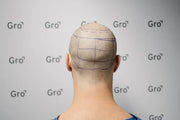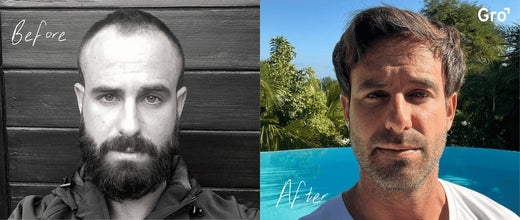Embarking on the journey to reclaim your confidence and embrace a revitalised sense of vitality often begins with the quest for a full, vibrant head of hair. At Gro Clinics, we recognise that hair loss is a reality many individuals grapple with daily. However, our focus remains on the positive transformations that can occur through our services, steering away from any negativity associated with hair loss.
In the realm of hair restoration, the Follicular Unit Extraction (FUE) technique has been a pivotal player, and in this blog, we'll delve into its intricacies, weigh the pros and cons, and shed light on why Gro's Precise Follicle Placement (PFP) method stands out as a beacon of innovation.
| Time Poor? Here’s the low down on FUE Hair Transplants |
| • Follicular Unit Extraction (FUE) hair transplant is a technique that extracts individual hair follicles from a donor site and transplants them to balding areas. |
| • The FUE technique was invented by Dr. Masumi Inaba in the late 1980s and his work paved the way for modern hair transplant methods. While FUE hair transplant results are generally permanent, there can be potential side effects, such as infection symptoms, discomfort, folliculitis, and continuing hair thinning post-transplant. |
| • Gro's Precise Follicle Placement (PFP) method provides a sophisticated, minimally invasive procedure ensuring natural appearances with high follicle density and no noticeable scars. This method, combined with a pricing structure based on the number of hairs rather than grafts, aims to maximise the use of finite donor hair resources. |
What is an FUE Hair Transplant?
Five years ago, the acronym FUE (Follicular Unit Extraction) was the buzzword on everyone's lips when it came to hair transplants. It was hailed as the pinnacle of hair restoration, the grand solution to our receding hairline woes. But like a trendy hairstyle from the past, has FUE been overtaken by more advanced, innovative techniques in the ever-evolving world of hair transplants.
Once the epitome of modern hair restoration, FUE involves the individual extraction and placement of hair follicles, promising minimal scarring and a natural look. It was a revolutionary leap forward from its predecessor, Follicular Unit Transplantation (FUT), which involved removing a strip of hair-bearing skin from the back of the scalp.
However, today's hair restoration landscape looks a bit different, much like how your hair might appear different under the harsh light of the bathroom mirror compared to the flattering, soft glow of a sunset. FUE is now being offered by a vast array of practitioners, each with their own interpretation of the technique. This has led to inconsistency in results, much like trying to recreate a salon-perfect hairstyle with a completely different set of styling tools and products.
FUE is now considered an outdated method when compared to modern hair transplant methods like Precise Follicle Placement (PFP).
Does FUE Hair Transplant Leave Scars?
Yes, FUE hair transplants can leave scars. However, the scars are typically small and fade over time. The size and visibility of the scars depend on several factors, including the doctors skill, the size of the grafts, and the patient's individual healing process.
In FUE hair transplant, individual hair follicles are extracted from the donor area using a small punch tool. This leaves behind small circular scars that are typically less than 1 millimeter in diameter. In most cases, these scars are not visible to the naked eye, even with short hair. However, in some cases, the scars may be more visible, especially if they are located in a visible area, such as the hairline.
Does FUE Hair Transplant Hurt?
FUE hair transplant involves minor discomfort during the local anaesthetic application, but the procedure itself is typically painless. Post-procedure discomfort can be managed with prescribed painkillers.
The Difference between FUE & FUT Hair Transplants
FUE and Follicular Unit Transplantation (FUT) are two popular hair transplant techniques. The main difference lies in how the hair follicles are extracted. FUT involves removing a strip of scalp from the donor area and dissecting it into individual follicular units. FUE, on the other hand, extracts individual follicles directly from the scalp, resulting in less scarring and faster recovery than FUT hair transplants.
The issue is that FUE, in its current form, is not a standardised method. The quality of results can differ dramatically, depending on the doctors skill, the instruments used, and even the approach taken in harvesting and implanting the grafts. It's akin to expecting a uniform crop of hair when each seed is planted at a different depth and angle. Unfortunately, this 'hair potluck' approach could leave you with patchy and inconsistent results.
What Makes PFP The Superior Hair Transplant Technique Over FUT?
This is what makes our treatment at Gro different:
| PFP | FUT | |
|---|---|---|
| Undetectable Scarring | ✓ | × |
| Hair Preservation Transparency | ✓ | × |
| Control on Angle, Depth, and Direction | ✓ | × |
| Performed By Doctor | ✓ | × |
| Short Recovery Time | ✓ | × |
The History of Hair Transplants
Hair transplants have a long and intriguing history dating back to the 19th century, evolving over time to become the refined procedures we know today.
Early Experiments: 19th to Early 20th Century
The first documented attempts at hair transplants can be traced back to the late 19th century. German professor Dom Unger conducted experiments on himself by moving hair from one area of his scalp to another.
In Japan, Dr. Okuda was the first to publish a method of transplanting hair to restore eyebrows and scalps of burn victims in the 1930s. His technique was groundbreaking, but his work was largely unrecognised because of World War II.
Birth of Modern Hair Transplants: Mid 20th Century
The advent of modern hair transplantation is attributed to Dr. Norman Orentreich, a New York dermatologist, who conducted the first successful hair transplant in the U.S in the 1950s. He developed the "donor dominance" theory, which suggests that hair follicles transplanted from areas resistant to balding (like the sides and back of the head) will maintain their resilience to hair loss, even when relocated to a balding area.
Evolution of Techniques: Late 20th to Early 21st Century
Initially, the transplantation involved large plugs or grafts of hair, which often led to an unnatural, 'doll-like' appearance.
The 1980s and 1990s saw the development of the mini and micrograft techniques, which transplanted smaller groups of hairs for a more natural look.
In the late 1980s, Dr. Masumi Inaba introduced the Follicular Unit Extraction (FUE) technique in Japan, where individual hair follicles are extracted and transplanted. This method leaves minimal scarring and has a quicker recovery time.
Present Day
The 21st century has seen further refinement in hair transplant techniques.
Here at Gro, we are at the cutting-edge of hair transplant techniques and offer the superior PFP (Precise Follicle Placement) Hair Transplant Method. This sophisticated, minimally invasive procedure guarantees natural appearances with a high follicle density and absence of noticeable scars. Concentrating on the meticulous positioning of each hair follicle, our PFP technique aims to emulate the density and aesthetics of naturally occurring hair.
Is FUE Hair Transplant Permanent?
FUE hair transplant results are generally permanent. The transplanted hair follicles, once established in their new location, continue to grow hair for a lifetime.
What are the potential risks or adverse effects for FUE Hair Transplants?
While FUE hair transplant leaves virtually no scarring, you may observe small white dots at the extraction sites, which often diminish over time.
Though uncommon, certain side effects can occur post-procedure. You should consult your doctor if you experience any of the following:
The Benefits of Gro's PFP Method
At Gro, our PFP (Precise Follicle Placement) Hair Transplant Method sets us apart. This is a refined, minimally invasive technique, ensuring natural-looking results with high density and no visible scarring. It focuses on the perfect placement of each hair follicle to achieve a density and aesthetic that rivals nature.
As the name suggests, Precise Follicle Placement has a major emphasis on the precise positioning of each hair follicle. It amalgamates the best aspects of both FUE and FUT, aiming for optimal density and naturalness while minimising any potential scarring. It's like the Avengers of hair transplants, bringing together the best of everything to save the day (or rather, the hair).
Gro Diary Spotlight
Melbourne-based brothers, Luke and Sassy Scott, who have made a splash on the TikTok scene, are now collectively on a mission to attain their ideal hairlines.
@lukeandsassyscott Balding in your 30s - watch our foreheads go from 0 to 10,000 hairs 🌱 #sassy #brother #funny #balding #hairtransplant #hairtransformation #fyp @Gro Clinics ♬ original sound - Luke And Sassy Scott
They've recently undergone hair transplant procedures and are set to chronicle their progress with us and their online audience. Brace yourself for an array of dynamic content and an emotional voyage as they capture their transformative journeys! 😂
Want to see more hair growth journeys? Visit the Gro Diary and witness the real-life transformations of our clients and observe the remarkable results first-hand.
Taking The Next Step In Your Hair Growth Journey
So, while FUE may have been the talk of the town a few years back, it's clear that the hair restoration industry is continuously evolving, with techniques such as PFP leading the charge towards more effective, more reliable hair restoration outcomes. It's important to remember that when it comes to hair transplants, what matters isn't necessarily the trendiest technique, but the one that offers you the most natural, long-lasting results.
Our dedicated Hair Growth Advisors provide personalised recommendations and support, understanding each client's unique needs and goals. We prioritise personalised care to ensure the best possible experience throughout your hair transplant journey.













